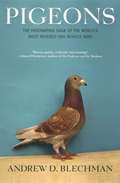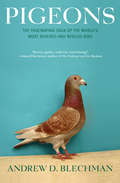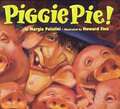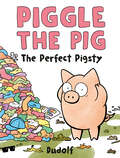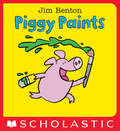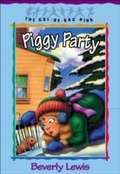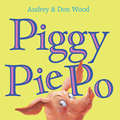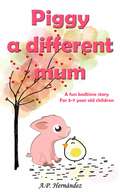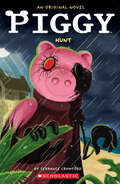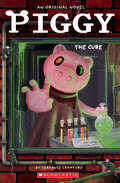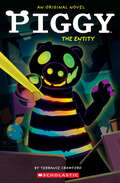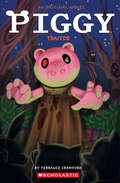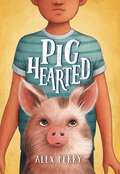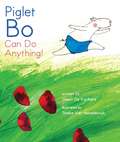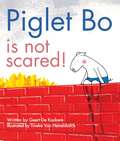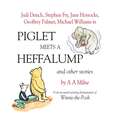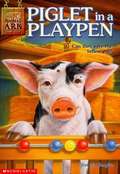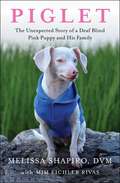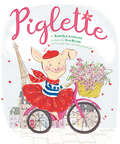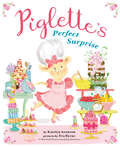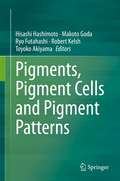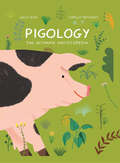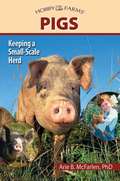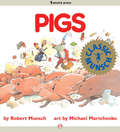- Table View
- List View
Pigeons: The Fascinating Saga of the World's Most Revered and Reviled Bird
by Andrew D. BlechmanFrom the Book Jacket: They have been worshiped as fertility goddesses and revered as symbols of peace. Domesticated since the dawn of man, they have been crucial to wartime communications for every major historical superpower from ancient Egypt to the United States and are credited with saving thousands of lives. One delivered the results of the first Olympics in 119 B.C. and another brought the news of Napoleon's defeat at Waterloo more than 2,500 years later. Charles Darwin relied heavily upon them to help formulate and support his theory of evolution. Yet the pigeon is reviled today as a rat with wings. How did we come to misunderstand one of mankind's most steadfast companions? In Pigeons, Andrew D. Blechman travels across the United States and Europe in a quest to chronicle the bird's transformation from beloved friend to feathered outlaw. From Brooklyn's Main Event, the pigeon world's equivalent of the Kentucky Derby, to the eighty-third Grand National, with its thousands of bizarre and beautiful show pigeons, and from a pigeon shoot where people pay to gun down live birds, to the nation's oldest and biggest squab farm, Blechman takes the reader deep into the weird and wonderful world of pigeon fanaticism. He meets with pigeon fanciers and pigeon haters alike, includingthe Queen of England's Royal Loft Manager and members of the radical "pro-pigeon underground"; chases Mike Tyson, America's most famous pigeon lover; and for the first time tells the remarkable story behind this seemingly unremarkable bird. You'll never look at a pigeon the same way again. ! ANDREW D. BLECHMAN is an award- winning journalist who has worked for the Los Angeles Times and the Des Moines Register. His writing has appeared in numerous publications, including Smithsonian magazine and The New York Times. He currently divides his time between Berkshire County, Massachusetts, and Germany.
Pigeons: The Fascinating Saga of the World's Most Revered and Reviled Bird
by Andrew D. BlechmanPigeons have been worshipped as fertility goddesses and revered as symbols of peace. Domesticated since the dawn of man, they’ve been used as crucial communicators in war by every major historical superpower from ancient Egypt to the United States and are credited with saving thousands of lives. Charles Darwin relied heavily on pigeons to help formulate and support his theory of evolution. Yet today they are reviled as "rats with wings.” Author Andrew D. Blechman traveled across the United States and Europe to meet with pigeon fanciers and pigeon haters in a quest to find out how we came to misunderstand one of mankind’s most helpful and steadfast companions. Pigeons captures a Brooklyn man’s quest to win the Main Event (the pigeon world’s equivalent of the Kentucky Derby), as well as a convention dedicated to breeding the perfect bird. Blechman participates in a live pigeon shoot where entrants pay $150; he tracks down Mike Tyson, the nation’s most famous pigeon lover; he spends time with Queen Elizabeth’s Royal Pigeon Handler; and he sheds light on a radical "pro-pigeon underground’ in New York City. In Pigeons, Blechman tells for the first time the remarkable story behind this seemingly unremarkable bird.
Piggie Pie!
by Margie PalatiniGritch the witch flies to Old MacDonald's farm for some pigs to make a piggie pie, but when she arrives she can't find a single porker.
Piggle
by Crosby BonsallFrom the book: Piggle? What kind of game is that? Homer and Bear know. Lolly, Molly, Polly and Dolly know, and so do Rabbit and Duck. Even Pig thinks he knows. How do you piggle? Beginning readers will love finding out in Crosby Bonsall's satisfying story about a boy who is looking for someone to play with This spirited sequel to the popular Who's A Pest? [available from Bookshare] will thoroughly delight young children.
Piggle the Pig: The Perfect Pigsty
by DudolfIntroducing an irresistible new character, sure to capture the hearts (and giggles) of readers everywhere, perfect for fans of Don't Let the Pigeon Drive the Bus and the Pig the Pug series!This one-of-a-kind picture book is a guaranteed laugh for messy kids ages 0–99."Whole-hog fun."--Kirkus ReviewsWhen Piggle's parents let him know that they'll be stopping by, preparing for their visit seems positively easy. All he has to do is put away several months' worth of laundry, remove an extraordinary amount of trash, and wipe down any surfaces that might be covered in grime and mildew (which is all of them). And wait... who is that living in the washing machine? Nothing your average pig can't handle!Children who dread room-cleaning day, adults who freeze up when facing the task of housecleaning, or just about anyone who has faced down a sink full of dishes will find Piggle's struggle relatable. Uniquely hilarious, Piggle the Pig will delight readers as he faces the universal struggle of preparing for unanticipated houseguests.
Piggy Paints: A Big & Little Book
by Jim BentonJim Benton brings on the humor in a brand-new line of board books!Piggy paints big. Piggy paints little.Piggy paints pigs with a kitty in the middle.Piggy paints little. Piggy paints big.Piggy paints a pretty little polka-dot pig.Jim Benton, the international bestselling author and illustrator of Dear Dumb Diary, presents a clever, rollicking new board book program that will leave toddlers wide-eyed and laughing. Fans of Sandra Boynton will rejoice in this fresh line of funny stories!Each board book features: - Hilarious stories based on early concepts - Endearing characters- Young, bold, colorful artwork
Piggy Party (The Cul-de-Sac Kids #19)
by Beverly LewisBook 19 in The Cul-De-Sac Kids chapter book series for young readers. When Carly Hunter takes the class guinea pig home for the weekend and decides to test Piggy's skill for weather-telling on Groundhog Day, trouble can't be far away.
Piggy Pie Po
by Audrey Wood Don WoodWho is Piggy Pie Po? Just the smartest (maybe), messiest (probably), silliest (definitely) piggy you'll ever meet. In these three small and playful stories, he's sure to become every child's most unforgettable new friend. Award-winning team Audrey and Don Wood's picture books have been loved by children and parents for more than twenty-five years. With perfect pacing and exuberant illustrations, Piggy Pie Po introduces a new character that will be embraced by the next generation of little ones.
Piggy, a Different Mum (For 3-7 Year Old Children): a Fun Bedtime Story (For 3-7 Year Old Children)
by Javier García Frutos A. P. HernándezPiggy woke up with an egg next to her. The egg came out of nowhere and Piggy needs to solve the mystery. Who does it belong to? How did it get there? Is anyone looking for it? Piggy wants to be a mum with all her heart and wants to keep it until it hatches. She wants to give it love and look after it. But her donkey-friend, John, convinces her to search for its mother beforehand. So Piggy and her faithful friend start a journey through the farm with the aim of solving the mysteries around the egg. This story deals with values such as responsibility, commitment, honesty, generosity and love in a fun and didactic way. A useful tool to teach these values for parents and guardians, primary school teachers, educators and psychologists.
Piggy: Hunt: An AFK Novel (Piggy)
by Terrance CrawfordDive into terrifying world of PIGGY in the third original illustrated novel based on the fan-favorite video game!There is a mystery to be solved, a cure to be found, and a horde of Infected to escape!Welcome back to the bone-chilling, pulse-pounding world of PIGGY, the survival-horror game that will have have you hearing haunting oinks in your sleep, guaranteed! This original story set in the world of the games is packed with pulse-pounding action, goosebump-giving scares, and more infected monsters than you can shake a wrench at!
Piggy: The Cure: An AFK Book
by Terrance CrawfordDive into terrifying world of PIGGY in this original novel based on the fan-favorite video game!There is a mystery to be solved, keys to be found, and an evil pig to escape!Welcome to the bone chilling, pulse-pounding world of PIGGY, the survival-horror game that will keep you up at night. Explore a frightening maze full of secrets to unearth and monsters that are out for blood! Can anyone make it out alive?
Piggy: The Entity: An AFK Book (Piggy)
by Terrance CrawfordDive into the terrifying world of PIGGY in the fourth original illustrated novel based on the fan-favorite video game!Secrets hidden in darkness, new enemies lurking in the shadows, and old mysteries finally coming to light!It's been ten months since Ben confronted the dark truths at the center of the Infection and things are - surprisingly - going well. But lately, he has started having bad dreams again. Dreams of an ominous, bow tie wearing figure with sinister intentions. And he's not the only one - people all over Lucella are having similar nightmares. Now Ben must assemble a team of friends both new and old to defeat The Entity and his sewer-dwelling legion before the island of Lucella falls into their evil clutches!
Piggy: Traitor (Piggy)
by Terrance CrawfordBrave the terrifying world of PIGGY in this official illustrated novel based on the hit ROBLOX game!Diego was separated from his family in the early days of the Infection. Since then, he has moved from town to town, and place to place -- getting by as best as he can. Recently, he has met and joined up with a motley crew of other survivors. After an encounter with a pack of the Infected, their numbers begin to dwindle as members of the group begin to disappear in mysterious and macabre ways. It soon becomes clear that not everyone in the group is telling the whole truth.Can Diego and his new friends discover the traitor amongst them before it's too late?
Pighearted
by Alex PerryCharlotte's Web meets My Sister's Keeper in this charming story told from the alternating perspectives of a boy with a fatal heart condition and the pig with the heart that could save his life.Jeremiah&’s heart skips a beat before his first soccer game, but it&’s not nerves. It&’s the first sign of a heart attack. He knows he needs to go to the hospital, but he&’s determined to score a goal. Charging after the ball, he refuses to stop…even if his heart does.J6 is a pig and the only one of his five brothers who survived the research lab. Though he's never left his cell, he thinks of himself as a therapy pig, a scholar, and a bodyguard. But when the lab sends him to live with Jeremiah's family, there&’s one new title he&’s desperate to have: brother.At first, Jeremiah thinks his parents took in J6 to cheer him up. But before long, he begins to suspect there's more to his new curly-tailed companion than meets the eye. When the truth is revealed, Jeremiah and J6 must protect each other at all costs—even if their lives depend on it.
Piglet Bo Can Do Anything!
by Geert De KockereCan he walk on water? Can he widen the beach? Can he pluck a star from the sky? Piglet Bo can do all of these things and more. He leaps over tall grasses, blows down a forest, and walks out onto a long pier, as far as it will take him. He looks to the deep sea, and although the pier will take him no farther, Piglet Bo will not be stopped. "I can go into the water,” he says. "If I like. If I dare. ” And with a leap of faith, he jumps. Piglet Bo finds friends on his journey--a whale, a pigeon, a bull--and they inspire and help him when they can, but ultimately it takes courage and daring for Piglet Bo to attempt the impossible. Piglet Bo is the bravest and most determined little piglet, with a heart set on adventure. There are no limits to what he can do, and young readers will fall in love with his sweet and endearing resolve. Geert De Kockere writes Piglet Bo’s adventures in simple, playful language, filled with light humor. Tineke Van Hemeldonck’s brilliant mixed-media illustrations bring the story to life, and even the littlest readers will have fun spotting the elusive, lucky four-leaf clover hidden on each page.
Piglet Bo Is Not Scared!
by Geert De KockerePiglet Bo insists that he is not scared. Not scared of anything and not scared of anyone. And if you think he seems scared, well, you’re misunderstanding the situation. Really, Piglet Bo can’t go into the dark cave because he doesn’t want to disturb the bats. And he can’t go into the deep pit because he’s pretty sure the termites are having a birthday party and it would be rude to show up without a gift. But what are those shadows lurking on each page? How long can Piglet Bo’s excuses last? Geert De Kockere’s whimsical story will capture the hearts of children and adults alike. This playful tale of a pig who just can’t admit he’s afraid is sure to get kids laughing out loud. Tineke Van Hemeldonck’s uniquely evocative mixed-media illustrations bring Piglet Bo Is Not Scared! to life and give it an imaginative, quirky feel. This charming story is for ages three and up.
Piglet Meets A Heffalump and Other Stories (Winnie the Pooh #1)
by A.A. MilneJoin this all-star cast including as they go on adventures and look for heffalumps with Pooh, Piglet and friends in the Hundred Acre Wood.Performed by incredible talent including Finty Williams, Stephen Fry, Sandi Toksvig, Robert Daws, Jane Horrocks, Geoffrey Palmer and Judi Dench, this classic Winnie the Pooh audiobook is perfect for keeping little ones entertained.Contains the following stories:In which Piglet meets a HeffalumpIn which Eeyore has a birthday and gets two presentsIn which Kanga and Baby Roo come to the Forest, and Piglet has a bathIn which Christopher Robin leads an expotition to the North PoleFor more amazing audio books featuring Pooh, Piglet, Tigger, Eeyore and other favourite friends, try:Winnie the Pooh: Tigger Comes To The Forest & Other Stories Winnie the Pooh: House At Pooh Corner Winnie the Pooh: Pooh Invents a New Game and Other Stories (P) Hodder Children's Books 1998
Piglet in a Playpen (Animal Ark #9)
by Ben M. BaglioMr. Gill's farm is having money troubles, and he tells his son, Brandon, that they can't afford to keep a runt piglet named Ruby. Can Mandy and James help Brandon secretly raise Ruby into a strong healthy pig, and also find help for the farm?
Piglet: The Unexpected Story of a Deaf, Blind, Pink Puppy and His Family
by Mim Eichler Rivas Melissa ShapiroNamed a Best Feel-Good Book by The Washington Post In the tradition of the beloved New York Times bestsellers Marley and Me and Oogy: The Dog Only a Family Could Love, a charming, inspirational memoir about empathy, resilience, kindness, and an adorable deaf blind pink dog.When Connecticut veterinarian Melissa Shapiro gets a call about a tiny deaf blind puppy rescued from a hoarding situation in need of fostering, she doesn&’t hesitate to say, &“yes.&” Little does she know how that decision will transform her, her family, and legions of admirers destined to embrace the saga of the indomitable pink pup. One of the most anxious dogs Melissa had ever encountered, the traumatized Piglet weighed under two pounds upon his welcome into the Shapiro household—which included Melissa&’s husband Warren and their three college-aged kids, plus six other rescued dogs. After weeks of reassurance, and lots of love, Piglet connected, gained confidence, and his extraordinary spirit emerged. Melissa soon forged a powerful bond with Piglet, allowing the two to communicate without sound or visual cues. Two months later, when the day arrived to say good-bye to the now dashing, six-pound pink boy dog with the larger than life spirit, Melissa faced a heart-wrenching decision. Could she hand him over to someone willing to give Piglet the full-time attention he required or could she adapt her schedule and her household to make a permanent place for him in her life and work? Of course, the answer was simple: love would find a way. Curious, engaged, and incredibly eager to learn, Piglet quickly became part of the family. What started out as a few simple Facebook posts of Piglet and his pack rapidly evolved into a global celebration of Piglet&’s infectiously positive mindset. Piglet: The Unexpected Story of a Deaf, Blind, Pink Puppy and His Family fully illustrates this heartwarming story of one special little puppy with a purpose to teach the power of empathy, love, and kindness.
Piglette
by Katelyn AronsonWill a pristine piglet find perfection in Paris?Piglette can be a bit particular by her siblings' standards. She always wants everything to be perfect. While her many brothers and sisters like rolling in the mud, Piglette prefers pampering in a mud bath. While her siblings eat slop, Piglette prefers pastries. But what she's most passionate about is flowers. She loves to smell the lilies and lilacs in the pasture. So Piglette decides her precise nose is destined for the perfume shops of Paris!But Piglette soon realizes that there's nothing more precious than the pleasant scents of home, and she finds a way to bring a little Parisian perfection back where she belongs. Debut author Kateyln Aronson and #1 New York Times bestselling illustrator Eva Byrne have created an unforgettable, playful piglet who stays true to herself and the message that home is where the heart is.
Piglette's Perfect Surprise
by Katelyn AronsonKatelyn Aronson and #1 New York Times bestselling illustrator Eva Byrne return with the sequel to Piglette, which Booklist praised: "Hand this crowd-pleaser to fans of Ian Falconer's Olivia and Jane O'Connor's Fancy Nancy."Piglette returns to Paris in search of the perfect present for Madame Paradee. When Piglette comes across a posh patisserie, she decides she will make the most extravagant cake the public has ever seen. But despite all her practice, her cake does not turn out as planned, and Piglette learns that sometimes perfection can be found in the simplest pleasures.
Pigments, Pigment Cells and Pigment Patterns
by Hisashi Hashimoto Makoto Goda Ryo Futahashi Robert Kelsh Toyoko AkiyamaThis book comprehensively summarizes the biological mechanisms of coloration and pattern formation of animals at molecular and cellular level, offering up-to-date knowledge derived from remarkable progress in the last 10 years. The brilliant coloration, conspicuous patterns and spectacular color changes displayed by some vertebrates and invertebrates are generally their strategies of the utmost importance for survival. Consists of mainly three parts, starts with introductory chapter, such as Pigments and Pigment Organelles, Developmental Genetics of Pigment Cell Formation, Adult Pigment Patterns, and Color Changes, this book introduces new pigment compounds in addition to classically known pigments and organelles, explains how the generation of multiple types of pigment cell is genetically controlled, describes the mechanisms underlying the zebrafish stripe formation as well as other animals and also summarizes the mechanism of physiological and morphological color changes of teleost, amphibian and cephalopod. Written by experts in the field, this book will be essential reading for graduate students and researchers in biological fields who are interested in pigmentation mechanisms of animals.
Pigology: The Ultimate Encyclopedia
by Daisy Bird Camilla PintonatoWelcome to the wonderful world of pigs! Pigology is filled with incredible pig facts told in a playful tone by Daisy Bird with irresistibly charming illustrations by rising star Camilla Pintonato.Pigs are full of unexpected surprises. Did you know that when a pig is happy, it will uncoil its curly tail and wag it just like a dog? Or that feral hogs can detect odors from seven miles away? Pigology delves into the history of pigs, pig breeds around the world, famous pigs, pigs in culture, and so much more, with engaging scenes from illustrator Camilla Pintonato. This lively, visual encyclopedia, a follow-up to Chickenology, has something to discover for everyone young and old: nature and animal loving young readers, pig enthusiasts, pig farmers, and pet pig owners alike!
Pigs
by Arie McfarlenThese Hobby Farms livestock care manuals will help both experienced and novice hobby farmers realize their own dreams of life on the farm - for pleasure and profit.
Pigs
by Robert Munsch Michael MartchenkoMegan is told to feed the pigs, but not to open the gate. She does of course, and the results are hilarious as the pigs help themselves to coffee and the newspaper at the breakfast table, follow Megan to school, and ride home by way of the school bus.
